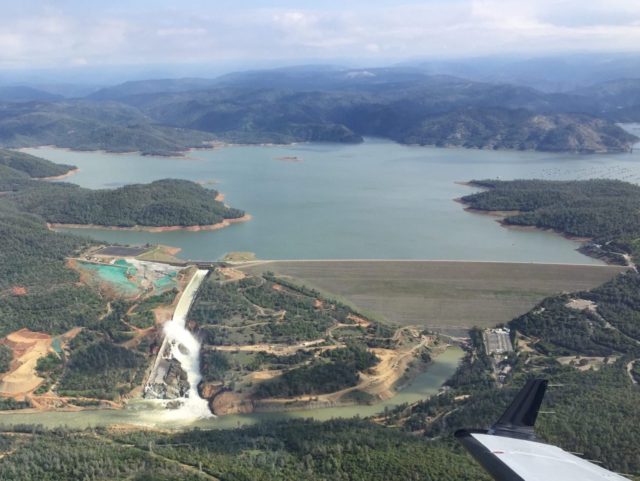Data from the U.S. Energy Information Agency suggest that the state could receive an extra $900 million in new hydro-electric revenue as a result of record California rain — and that the cash could pay for some of the damage to the Oroville Dam, the Los Angeles Aqueduct, and much of California’s key flood control infrastructure.
California is racking up monstrous repair bills just to stabilize its crumbling flood control infrastructure, which has suffered years of underinvestment and bare-bones maintenance. The most glaring example of this under-investment was on display in the near structural collapse, and 200,000 downstream evacuations, associated with the Oroville Dam crisis.
According to the latest report from the California Department of Water Resources to the U.S. Federal Energy Regulatory Commission’s Division of Dam Safety and Inspections regarding the inadequacy of the Oroville Dam’s failing main spillway: “It is also noted that the [spillway] slab is only 12-inches in thickness, and at the herringbone drains, the thickness is further reduced. In some areas of the foundation of the chute slab, compacted clay was used to fill depressions in the rock foundation.”
Breitbart News obtained the Oroville Dam’s annual “Inspection of Dam and Reservoir in Certified Status” by the State of California Division of Safety of Dams for the years 2014, 2015 and 2016, and forwarded the reports to dam safety expert Scott Cahill. He estimates that the repair job will cost at least $600 million.
The cost estimate includes $50 million to drill holes and inject grout into the leaking dam; $300 million for the main spillway; $50 million to replace the water gate; and $200 million to cement and anchor the emergency spillway.
Breitbart News also reported that Los Angeles Mayor Eric Garcetti declared an safety emergency on March 20, based on warm weather snowmelt in the Sierras that is expected to cause flooding and structural damage to the L.A. Aqueduct. Given known subsidence problems, repair costs for the 222-mile aqueduct will be at least $100 million.
But according to the U.S. Energy Information Agency, with the drought over as the result of one of the wettest winters on record, the California’s Sierra Nevada Mountain snowpack levels will have increased from about zero in April 2015, to an expected 158% of normal for April 2017. More importantly, the snow water equivalent (SWE) — the total amount of water contained within the snowpack — is an additional 158 percent of a normal year.
The combination of a huge and more water-dense snowpack means that the potential runoff volume will be about 250 percent of normal, and could last for a couple of years.
During the five-year drought, virtually cost-free hydro-electric power generation fell from supplying about 18 percent of state’s annual demand to fulfilling only 8 percent. The deficit supply difference was made up by paying to push up highly flexible natural gas-generated electricity from 45 percent of California’s supply to 58 percent.
Due to higher imported electricity purchases, California’s total electric bill jumped from about $8 billion to about $9.3 billion during the drought. As a result, California’s retail electric rates averaged 23 cents per kilowatt hour, versus a U.S. average of 13 cents.
Breitbart News projects that if electric demand remains the same, California hydro-electric power should generate about $900 million more in revenue this year versus the last four years of drought.
Although there are no assurances that this increased hydro-electric cash flow will be “sustainable,” Breitbart News reported that the latest forecasters’ observation for the oscillation between the normally dry years of the La Niña to the wet El Niño, predict an increasing probability that a strong El Niño could drench California again next year.

COMMENTS
Please let us know if you're having issues with commenting.